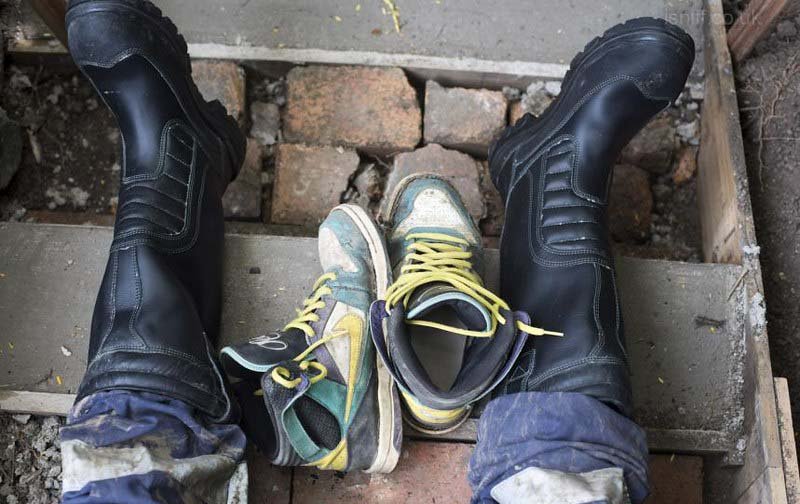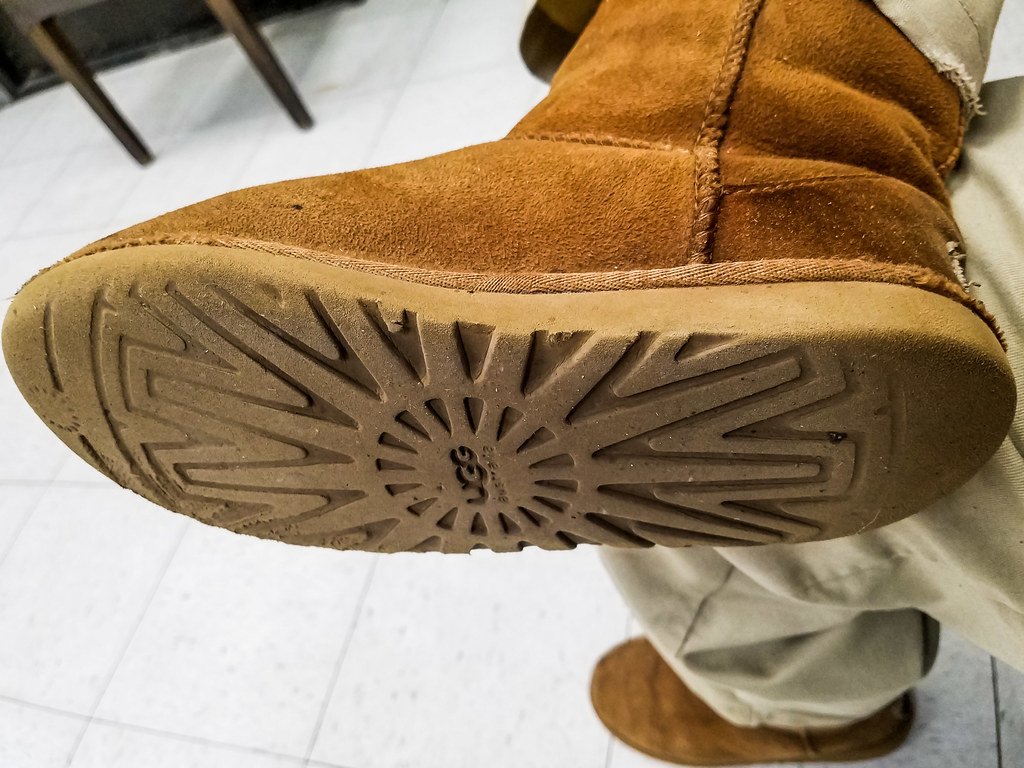It’s an easy trap to fall into admiring the sleek design and stylish colors of work boots, exclusively to discover later on that they don’t fit properly. The right fit can make a big difference when it comes to comfort and productivity. So, how should work boots fit?
The University of Wollongong, Australia conducted research that unveiled an alarming problem wearing the wrong size of work boots could have painful consequences such as bunions, corns, lower limb pain, calluses, and other foot issues. In many cases, workers experience discomfort simply because their boots do not fit properly.
A work boot should fit snugly around the foot, allowing toe and heel room but not too much to cause discomfort. The ankle should fit comfortably with the laces tightened. The arch ought to be supported and the mid-foot slightly loose. The length should not be too long or too short.
How Should Work Boots Fit?
For any job that involves hard labor, you need a good pair of work boots. They should come with a robust midsole and arch-supporting shank, as well as an elevated heel. Their shorter design helps minimize wear and tear on your trousers when you’re dealing with rough surfaces.
Securely-fitting work boots not only reduce the risk of injuries but also help keep you comfortable, so you can stay productive throughout the day.
Following are some points to keep in mind when finding the right fit work boot:
Check Size:
When you’re looking for the perfect pair of work boots, the size is the most important factor to consider. With all the different sizes available, you should have no trouble finding a size that fits you. You should try on multiple sizes and styles if need be. You may also want to try different insoles and liners if the boots feel too tight.
The right fit should be determined by the length and width of your feet as well as the amount of padding. Many work boots are made with a canvas upper, but if they’re too stiff, you can replace the insole with your own. Hard plastic soles can also add stability, so make sure you find boots that provide the right amount of support.
Select Your Style:
Style is the name of the game when it comes to working boots. From eye-popping colors and on-trend designs to materials that can brave any weather, you’ll find the right pair that makes a statement. Whether you’re looking to dress to impress or just stay safe on the job, the right work boots can be the perfect accessory to your work wardrobe.
Not only do they look great, but they can also protect from the elements and hazardous work environments. So, when you’re ready to choose a pair, remember to always consider your unique style and safety needs. With the right pair of boots, you’ll be ready to take on the world in comfort and style.
Look for perfect-fit Socks:
During the winter, put your feet in the lap of luxury with the perfect socks. Synthetic or wool socks lined with cotton will keep your tootsies toasty and dry. As the weather warms and the sun shines, switch to lightweight polyester socks with breathable fabric to keep your feet cool and comfortable.
Make sure you try both boots on:
Before you select your ideal pair of boots, don’t forget to try on both! It may be tempting to walk outside with just one, but comparing the fit of both simultaneously is the best way to ensure you have the right fit. So, slide into both and stand tall in your perfect pair!
Once you’ve put on the boot, check for the right size:
Don’t let ill-fitting work boots ruin your style. Make sure that you choose the correct size, and if it’s too tight, use pliers to loosen the laces for extra room. Don’t be afraid to take a chance and try on a pair of new boots; you can always return them if they don’t fit. Your work boots should be both comfortable and attractive, not just protective and comfortable while working.
How to Measure Your Foot Width to Fit Your Work Boots?

Find out the width of your foot in millimeters. The ideal way to measure it is to locate the widest part of your foot, which is typically right in front of your toes where they fan out.
Given below is the step-by-step instruction on how to measure your foot width to fit your work boots:
- To start, lay a ruler on a stable surface like a wood or tile floor.
- Keep your toes at the 0mm mark, and make sure you have your foot flat on the ruler.
- Ensure you’re on an even part of the measurement area, and keep your foot pressed firmly against the ruler as you lift your heel. Look straight ahead and measure the distance between your heel and the ruler.
Note: Be gentle with the ruler, for pressing too hard can cause it to bend. Bruised or crumpled foam boards can also lead to inaccurate readings.
4. Slide the edge of a pencil (eraser out) underneath your toes, making sure that the distance from the 0mm mark is maintained. Get someone to mark the top of the pencil.
5. Draw a line from the longest point of your toes and continue in an inward direction until you reach the heel of the foot.
6. If you are uncertain of which foot is larger, simply repeat steps 2-5 for the other foot and you will get an average measurement.
Common Boot Fit Problems
A recent investigation by the American Podiatry Association (APA) has discovered that overall fitness (Fitness in terms of user’s feet) and the design of work boots have a remarkable effect on the feet of workers. The research revealed that those who don’t have their work boots adequately fitted to their feet are more vulnerable to foot strain, exhaustion, and other foot discomforts.
Don’t despair if your boots don’t fit properly; there are plenty of potential causes. From shoes to socks, it could be any one of them causing the problem. Here’s a quick overview of some of the most common boot fit issues.
Thin Socks:
If your sock game isn’t up to scratch, why not take matters into your own hands? Cut them up to your ankle and get the fit you desire. For further reinforcement, try wearing extra socks for the day to avoid any unwanted sagging.
Insoles:
Changing your insoles to thicker ones may provide the cushioning and comfort you require. If you find that your boots still aren’t fitting snugly after a change of insoles, then it may be time to invest in a new pair of shoes.
Shoes:
Work boots that are too roomy may cause blisters and discomfort if your feet shift and slide around inside them. The best way to prevent this is to invest in a new, well-fitted pair of boots to help keep your feet comfortable and secure throughout the day.
Wrong Shoe Size:
When it comes to buying shoes, always make sure you get your feet measured! But keep in mind, the same size in different brands may fit differently. If you find that the pair of boots you purchased doesn’t fit quite right, there are a few adjustments you can make to get the ideal fit. Additionally, you can switch out your boots for shoes, or take the plunge and invest in custom-made footwear that comes with thicker insoles for that extra bit of room.
How Do You Determine Whether Your Work Boots Are Too Large Or Too Small?

Too Large:
Your work boots should never reach too high up; your ankle is slightly below the bone and should be just right. Toes should meet the front of the boot, with no space between the back and your toe tips. If you feel slipping when going up or down hills, an inability to keep the toes flat on the floor when standing, or discomfort when bending down, then your shoes may be too wide or long.
Too Small:
For the majority of us, our feet are a smidgen bigger than our shoes. If your feet are larger, it’s recommended to go up a size from your regular size. But if you have feet on the wider side, or even if they feel a bit tight, you may want to consider going up a half or full size.
There is no worse feeling than having your toes squished in your work boots, especially when you’re standing, walking, or driving. This can cause painful blisters and can take a toll on your feet. On the other hand, buying shoes that are too wide can be just as hazardous in the long run.
FAQs
Final Thoughts
There is no one-size-fits-all answer when it comes to finding the right fit for work boots. It is important to consider the type of work being done, the type of terrain expected to be encountered, and the individual’s foot size and shape. Moreover, the boots should be tried on while wearing similar socks or insoles to those that will be used while working and should be broken in before the first use.
Ultimately, the ideal fit should provide ample protection, excellent traction, and a comfortable fit that is neither too tight nor too loose. With a little bit of effort in the selection process, the perfect pair of work boots can be found, ensuring optimum safety and performance at work.

I’m Richard Gravener, founder and editor of Bootzine. I have 19 plus years as Safety Officer in the construction industry. I have been qualified as a Safety Inspector since December of 2000, and have been a Workplace Safety Coordinator/Advisor since September of 2008.
Workplace safety First – Therefore, it’s crucial for workers to have good footwear to protect their feet from different dangers at work! On this blog, I aim to share all my knowledge and expertise in dealing with workplace safety, especially in choosing the right footwear for different jobs and foot care, hopefully, you can get something out of it. Enjoy!

